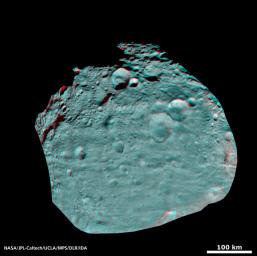
|
Vesta’s Surface in 3-D: An Ancient, Cratered Surface
- Click the image above for a larger view
- Full-Res JPEG (2372 x 2360) (399.9 kB)
- Full-Res TIFF (2372 x 2360) (16.8 MB)
Caption:
This image of the giant asteroid Vesta obtained by NASA's Dawn spacecraft shows the surface of the asteroid from an orbit of about 1,700 miles (2,700 kilometers) above the surface. Numerous impact craters illustrate the asteroid's violent youth. By counting craters on distinct geological surfaces scientists can deduce relative ages of the asteroid's surface. This 3D view provides scientists the opportunity to learn more about the morphology of craters on asteroids and physical properties of the material at Vesta's surface.
Use red-cyan (red-blue, or red-green) glasses for a 3-D view of the image. This image was obtained at an altitude of 1,700 miles (2,700 kilometers) altitude above the surface of Vesta. Image resolution is about 260 meters per pixel.
Background Info:
The Dawn mission to Vesta and Ceres is managed by NASA's Jet Propulsion Laboratory, a division of the California Institute of Technology in Pasadena, for NASA's Science Mission Directorate, Washington. UCLA is responsible for overall Dawn mission science. The Dawn framing cameras were developed and built under the leadership of the Max Planck Institute for Solar System Research, Katlenburg-Lindau, Germany, with significant contributions by DLR German Aerospace Center, Institute of Planetary Research, Berlin, and in coordination with the Institute of Computer and Communication Network Engineering, Braunschweig. The Framing Camera project is funded by the Max Planck Society, DLR, and NASA/JPL.
More information about Dawn is online at http://www.nasa.gov/dawn and http://dawn.jpl.nasa.gov .
Cataloging Keywords:
| Name | Value | Additional Values |
|---|---|---|
| Target | 4 Vesta | |
| System | Main Belt | |
| Target Type | Asteroid | |
| Mission | Dawn | |
| Instrument Host | Dawn | |
| Host Type | Orbiter | |
| Instrument | Framing Camera (FC) | |
| Detector | ||
| Extra Keywords | Color, Crater, Impact | |
| Acquisition Date | ||
| Release Date | 2011-09-16 | |
| Date in Caption | ||
| Image Credit | NASA/JPL-Caltech/UCLA/MPS/DLR/IDA | |
| Source | photojournal.jpl.nasa.gov/catalog/PIA14707 | |
| Identifier | PIA14707 | |
